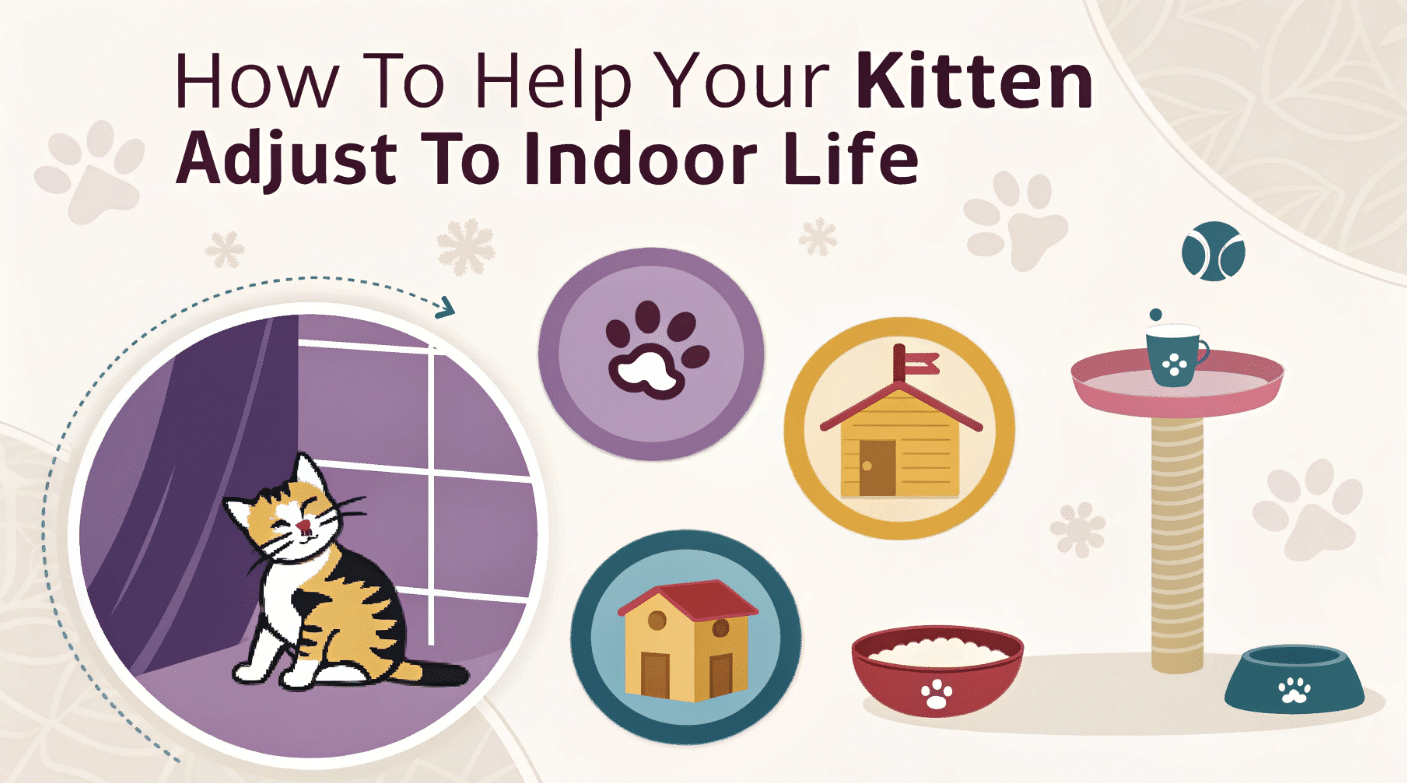
Welcoming a kitten into your home marks the beginning of an exciting journey. Ensuring their comfort and security indoors is paramount for their well-being and development. Opting for an indoor lifestyle provides significant advantages, including protection from outdoor hazards and a controlled environment conducive to their growth. While research indicates that cats with access to secure outdoor enclosures may exhibit reduced stress levels, a thoughtfully designed indoor space can offer comparable psychological benefits.
Through patience and a strategic approach, you can foster a thriving indoor environment for your kitten. Successful domestication hinges on establishing a nurturing habitat that encourages safe exploration and playful interaction.
Preparing Your Home for a Kitten
Bringing a kitten into your home is a delightful experience, but it requires careful preparation to ensure their safety and comfort. As a new kitten parent, you must create an environment that allows your furry friend to explore and play without encountering hazards.
This section will guide you through the essential steps to kitten-proof your space and create a cozy environment for your new companion.
Kitten-Proofing Your Space
Kittens are naturally curious and love to explore every nook and cranny. To keep them safe, you need to kitten-proof your home effectively.
Remove Hazardous Items
Begin by removing any items that could pose a danger to your kitten. Secure loose wires and cables, as kittens might chew on them. Store cleaning supplies, medications, and other toxic substances in cabinets or high shelves. Ensure that small objects, which could be swallowed, are out of reach.
Keep your toilet lid down to prevent your kitten from falling in or drinking from it.
Secure Windows and Balconies
Kittens are agile climbers and may attempt to explore windowsills and balconies. Install screens or safety nets on windows to prevent accidental falls. If you have a balcony, consider using a protective barrier to keep your kitten from venturing too far.
These precautions will help you create a safe indoor environment for your kitten.
Creating a Cozy Environment
A comfortable and inviting space will help your kitten feel at home. Providing the right amenities will encourage them to relax and enjoy their new surroundings.
Set Up a Comfortable Sleeping Area
Kittens require ample rest to grow and develop. Designate a quiet corner of your home as their sleeping area. Provide a soft bed or blanket where they can curl up and feel secure. Consider placing the bed in a location with minimal foot traffic to ensure uninterrupted sleep.
Provide Scratching Posts and Toys
Kittens have a natural instinct to scratch, which helps them maintain healthy claws and relieve stress. Offer scratching posts or pads to satisfy this urge and protect your furniture. Also, provide a variety of toys to keep your kitten entertained and mentally stimulated. Interactive toys, such as feather wands or balls, can encourage play and exercise.
Following these steps helps you create a safe, welcoming environment for your kitten. Proper preparation turns your home into a haven for your kitten to thrive and grow into a happy, healthy cat.
First Steps: Vet Visits and Health Checks
Welcoming a new kitten into your home is a joyful experience, but ensuring their health and well-being requires immediate attention. Taking the kitten to the vet is a crucial first step in this journey. This visit not only safeguards your kitten’s health but also helps prevent the spread of communicable diseases.
Early veterinary care sets the foundation for a healthy life.
Importance of a Vet Visit
A vet visit is essential for your kitten’s health. During this visit, the veterinarian will conduct a thorough examination to identify any potential health issues. They will check for fleas, worms, and other parasites, both external and internal.
The vet will also assess for congenital issues such as oral abnormalities or umbilical hernias.
Schedule Vaccinations and Check-Ups
Vaccinations are vital for protecting your kitten from common feline diseases. Schedule these vaccinations as soon as you bring your kitten home, ideally by eight weeks of age. Regular check-ups will ensure that your kitten remains healthy and receives timely medical attention if needed.
Discuss Diet and Nutrition
Nutrition plays a significant role in your kitten’s development. Discuss your kitten’s dietary needs with your veterinarian to ensure they receive a balanced diet. The vet can recommend specific foods that support growth and overall health.
Proper nutrition will help your kitten grow into a strong and healthy cat.
What You Need for a Healthy Kitten
Creating a nurturing environment involves more than just medical care. Providing the right supplies and tools will support your kitten’s health and happiness.
Essential Supplies Like Litter Box and Food
A litter box is a must-have for any indoor kitten. Choose one that is easy for your kitten to access and clean it regularly to maintain hygiene. High-quality kitten food is also essential. Look for food that meets the nutritional requirements for kittens, as they need more protein and calories than adult cats.
Recommended Toys and Grooming Tools
Toys are not just for entertainment; they play a crucial role in your kitten’s physical and mental development. Provide a variety of toys to keep your kitten engaged and active. Grooming tools, such as brushes and nail clippers, are also important. Regular grooming helps maintain your kitten’s coat and prevents matting.
Taking the kitten to the vet and providing the necessary supplies will ensure a healthy start for your new furry friend. With proper care and attention, your kitten will grow into a happy and healthy cat.
How to Domesticate a Kitten
Welcoming a kitten into your home is a heartwarming experience. However, if you encounter a feral kitten, the process of domestication requires patience and understanding. Learning how to domesticate a kitten involves creating a safe and nurturing environment where trust can flourish.
This section will guide you through the steps to tame a feral kitten and build a strong bond with your new furry friend.
Tame a Feral Kitten
Taming a feral kitten can be a rewarding journey. These kittens often have little to no human interaction, making them wary of people. To tame a feral kitten, you need to create a controlled environment that encourages trust and security.
Confine to a Small Space Initially
Start by confining the feral kitten to a small, quiet space. A bathroom or a small room works well. This limited area helps the kitten feel secure and reduces overwhelming stimuli. Ensure the space includes essentials like a litter box, food, water, and a cozy bed.
This setup allows the kitten to acclimate to its new surroundings without feeling threatened.
Use Food to Build Trust
Food plays a crucial role in taming a feral kitten. Offer meals at regular intervals to establish a routine. Sit quietly nearby while the kitten eats, allowing it to associate your presence with positive experiences. Gradually, you can move closer during feeding times.
This approach helps the kitten see you as a source of nourishment and safety, fostering trust over time.
Bonding with the Kitten
Building a bond with your kitten is essential for successful domestication. This process involves gentle interactions that encourage the kitten to feel comfortable and secure in your presence.
Spend Time Sitting and Talking
Spend time sitting near the kitten’s space, speaking softly to it. Your voice can become a comforting presence. Avoid direct eye contact initially, as this can be intimidating. Instead, let the kitten approach you at its own pace. This method helps the kitten become accustomed to your presence and voice, laying the groundwork for a trusting relationship.
Use Slow and Gentle Movements
When interacting with the kitten, use slow and gentle movements. Sudden actions can startle the kitten and hinder progress. Extend your hand slowly, allowing the kitten to sniff and explore. Over time, the kitten will become more comfortable with your touch.
This gradual approach helps the kitten feel safe and secure, strengthening your bond.
Understanding how to domesticate a kitten requires patience and empathy. By following these steps, you can successfully tame a feral kitten and create a loving home environment. Remember, each kitten is unique, and progress may vary.
With dedication and care, your kitten will grow into a confident and affectionate companion.
Socializing Your Kitten
Introducing the kitten to your home is a joyful experience, but it also requires careful attention to socialization. Socializing the cat early on helps them adapt to their new environment and develop into well-adjusted companions. This process involves spending quality time with your kitten and gradually introducing them to other pets in your household.
With patience and the right approach, you can help your kitten become a confident and friendly member of your family.
Spending Quality Time
Spending quality time with your kitten is essential for building a strong bond and ensuring they feel comfortable in their new surroundings. Engaging in playtime and bonding activities not only strengthens your relationship but also provides mental and physical stimulation for your kitten.
Engage in Playtime and Bonding Activities
Playtime is a crucial part of socializing the cat. Use toys like feather wands or small balls to encourage your kitten to chase and pounce. These activities mimic natural hunting behaviors and help your kitten expend energy. Regular play sessions also provide opportunities for bonding, as your kitten learns to associate you with fun and positive experiences.
Use Gentle Handling to Build Trust
Gentle handling is key to building trust with your kitten. Start by softly petting them and gradually progress to picking them up. Encourage friends and family to interact with your kitten, as this will help them become accustomed to different people.
Remember, kittens are sensitive to touch, so always handle them with care to avoid causing stress or fear.
Introducing Other Pets
Introducing the kitten to your home with existing pets requires a thoughtful approach. Gradual introductions ensure that all animals feel safe and comfortable, reducing the likelihood of conflicts.
Gradual Introductions to Other Animals
Begin by allowing your kitten to explore their new environment without direct contact with other pets. Use a baby gate or closed door to let them see and smell each other from a distance. Over time, supervise short interactions, gradually increasing their duration as your kitten becomes more comfortable.
This method helps prevent territorial disputes and fosters positive relationships between your pets.
Monitor Interactions for Safety
Always monitor interactions between your kitten and other animals to ensure safety. Look for signs of stress or aggression, such as hissing or growling, and intervene if necessary. Provide separate spaces for each pet to retreat to if they need a break.
With patience and careful observation, your kitten will learn to coexist peacefully with other animals in your home.
Socializing the cat is a rewarding process that lays the foundation for a harmonious household. By spending quality time with your kitten and carefully introducing them to other pets, you can help them develop the social skills they need to thrive.
Remember, every kitten is unique, so be patient and adjust your approach as needed to meet their individual needs.
Establishing a Routine
Creating a routine for your kitten is essential for their development and well-being. A structured schedule provides stability and security, reducing stress and anxiety. As a kitten care specialist, I have seen firsthand how routines contribute to a cat’s overall happiness and health.
Let’s explore how you can establish a feeding and sleeping schedule, along with play and exercise routines, to help your kitten thrive.
Feeding and Sleeping Schedule
A consistent feeding and sleeping schedule is essential for your kitten’s growth and overall well-being. Regular meal times and sleep patterns help your kitten feel secure and establish healthy habits.
Consistent Meal Times
Feed your kitten at the same times each day. This consistency helps regulate their metabolism and digestion. Kittens typically require more frequent feeding than adult cats, so plan for multiple small meals throughout the day. Use high-quality kitten food that meets their nutritional needs. Here’s a simple feeding schedule to consider:
|
Age (Weeks) |
Meals per Day |
Portion Size (per meal) |
|---|---|---|
|
8-12 |
4 |
1/4 cup |
|
12-24 |
3 |
1/3 cup |
|
24+ |
2-3 |
1/2 cup |
Encourage Regular Sleep Patterns
Kittens require ample sleep to support their rapid growth. Create a quiet, comfortable sleeping area where your kitten can rest undisturbed. Encourage regular sleep patterns by dimming lights and reducing noise during nap times.
A predictable bedtime routine, such as gentle petting or a soft lullaby, can signal to your kitten that it’s time to wind down.
Play and Exercise
Play and exercise are vital for your kitten’s physical and mental development. Engaging in daily play sessions and providing interactive toys will keep your kitten active and stimulated.
Daily Play Sessions
Set aside time each day for interactive play with your kitten. Use toys that mimic prey, like feather wands or laser pointers, to encourage natural hunting behaviors. These sessions not only provide exercise but also strengthen your bond with your kitten.
Aim for at least two 15-minute play sessions daily to keep your kitten engaged and happy.
Interactive Toys for Mental Stimulation
Provide a variety of toys to challenge your kitten’s mind. Puzzle feeders, treat-dispensing balls, and interactive toys can keep your kitten entertained and mentally stimulated. Rotate toys regularly to maintain your kitten’s interest and prevent boredom.
Remember, a mentally stimulated kitten is a happy and well-adjusted cat.
Establishing a routine for your kitten involves creating a balanced schedule that includes feeding, sleeping, playtime, and exercise. This structure helps your kitten feel secure and supports their overall development. With patience and consistency, you can nurture a healthy and contented cat.
Ensuring Comfort and Safety
Creating a safe and comfortable environment for your kitten is crucial to their overall well-being. As you welcome your new furry friend into your home, it’s important to provide spaces where they can retreat and feel secure. Monitoring their behavior and health will also ensure they remain happy and healthy.
Safe Spaces for Retreat
Kittens, like all cats, need places where they can relax and feel safe. Providing these spaces helps reduce stress and anxiety, allowing your kitten to thrive indoors.
Designate Quiet Areas for Rest
Designate specific areas in your home where your kitten can rest undisturbed. These quiet zones should be away from high-traffic areas and loud noises. A cozy corner with a soft bed or blanket can serve as a perfect resting spot. This setup not only offers comfort but also gives your kitten a sense of ownership over their space.
Provide Hiding Spots for Security
Kittens often seek out hiding spots when they feel threatened or overwhelmed. Offering a variety of hiding places, such as cardboard boxes or covered beds, can help them feel secure. These spots allow your kitten to retreat when they need a break from the hustle and bustle of daily life.
Research has shown that creating a calming environment with hiding spaces can significantly reduce stress levels in cats.
Monitoring Behavior and Health
Keeping a close eye on your kitten’s behavior and health is crucial for detecting any issues early. Regular monitoring helps you address potential problems before they escalate.
Recognize Signs of Stress or Illness
Understanding the signs of stress or illness in your kitten is vital. Look for changes in appetite, grooming habits, or litter box usage. Excessive hiding, aggression, or vocalization may also indicate stress. If you notice any of these signs, consult your veterinarian for guidance.
Early intervention can prevent minor issues from becoming serious health concerns.
Regularly Check for Changes in Behavior
Regularly observe your kitten’s behavior to ensure it is adapting well to its indoor environment. Keep track of their playfulness, social interactions, and energy levels. Sudden changes in behavior might signal underlying health issues or environmental stressors.
Maintaining a journal of your kitten’s behavior can help you identify patterns and address concerns promptly.
Ensuring comfort and safety creates an environment for your kitten to grow into a confident, content cat. Providing safe spaces and monitoring health builds a foundation for a happy, healthy life together.
Potential Challenges and Solutions
Welcoming a kitten into your home is a joyful experience, but it can come with its own set of challenges. Understanding these potential issues and knowing how to address them will help you create a harmonious environment for your new furry friend.
Let’s check out some common concerns and mistakes to avoid when caring for your kitten.
Common Concerns
Addressing Litter Box Issues
Litter box problems can be frustrating for both you and your kitten. However, with patience and the right approach, you can resolve these issues effectively. Ensure that the litter box is easily accessible and cleaned regularly. Kittens, even as young as six weeks old, can learn to use the litter box if it’s in a convenient location.
If your kitten is avoiding the litter box, consider trying a different type of litter or relocating the box. Consistency and cleanliness are key to encouraging proper litter box habits.
Managing Excessive Meowing
Excessive meowing can indicate that your kitten is trying to convey an important message. It might be hunger, loneliness, or discomfort. Pay attention to the context of the meowing to understand its cause. Ensure your kitten has access to food, water, and a comfortable resting place. Spend quality time playing and bonding with your kitten to alleviate loneliness.
If the meowing persists, consult your veterinarian to rule out any underlying health issues.
Common Mistakes to Avoid
Overfeeding or Underfeeding
Proper nutrition is crucial for your kitten’s growth and development. Overfeeding can lead to obesity, while underfeeding can result in malnutrition. Follow the feeding guidelines provided by your veterinarian or the pet food manufacturer. Kittens require more frequent meals than adult cats, so plan for multiple small meals throughout the day. Monitor your kitten’s weight and adjust portion sizes as needed to maintain a healthy weight.
Neglecting Socialization
Socialization is essential for your kitten’s emotional and behavioral development. Neglecting this aspect can lead to a shy or fearful cat. Introduce your kitten to various people, environments, and experiences gradually. Encourage positive interactions with gentle handling and play.
Socialization helps your kitten become a well-adjusted and confident cat. Remember, the socialization window is most effective between 3 to 9 weeks of age, so start early.
Understanding these potential challenges and solutions will help you provide the best care for your kitten. With patience and dedication, you can overcome these obstacles and enjoy a rewarding relationship with your new feline companion.
Helping your kitten adjust to indoor life is a rewarding journey filled with love and discovery. By following the steps outlined, you create a safe and enriching environment for your kitten. Remember, patience and consistency are key. Your kitten may take time to adapt, but with your care, they will thrive indoors. Indoor life offers numerous benefits, including increased safety and health for your cat.
Share your experiences and seek advice if needed. Every kitten is unique, and your dedication will ensure they grow into a happy and healthy cat.

In her previous life, Lisa traveled extensively, both for work and leisure. After the pandemic struck, Lisa locked up her luggage and adopted a cat ever since.
Lisa is now an avid cat lover, she devotes most of her free time serving as butler to her adorable feline at home. When she is not with her cat, she can be seen using her phone sourcing for the latest cat supplies online.


